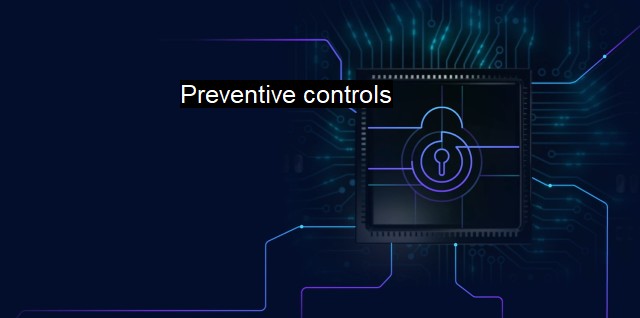What are Preventive controls?
Strengthening Cybersecurity with Preventive Controls: Technical and Administrative Measures to Mitigate Data Breaches and Malware Attacks, Including Antivirus Software and Vulnerability Assessments.
"Preventive controls" is a comprehensive term in the cybersecurity domain, specifically referring to the strategies, methods, and techniques implemented proactively to deter potential threats or breach attempts in their inception stages, rather than responding to them after they have occurred. Encryption and strong user identification and authentication processes, antivirus software, and firewalls are all examples of preventive controls. they are the shields and barriers of a network that help guard against external or internal attacks.Preventive controls, which directly interact with potential threats, can be classified into two categories: technical and non-technical preventive safeguards.
Technical Preventive Controls are predominantly software and hardware based. Firewalls are perhaps the most well-known technical preventive controls. They act as the barrier between trusted and untrusted networks, surveying and controlling the incoming and outgoing network traffic based on predetermined security rules. Intrusion Prevention Systems (IPS) is another technical preventive control tool that can identify potential threats and respond instantly to shut down attacks.
Antivirus software falls under technical preventive controls. Antivirus programs keep systems secure by detecting and neutralizing malware such as viruses, worms, spyware, and ransomware before they can infiltrate and compromise the system. The software typically combines traditional signature-based threat identification with advanced technologies like artificial intelligence and machine learning to recognize and combat the latest threats. Effective antivirus programs also include real-time scanning to monitor systems continuously for potential threats.
Encryption is another crucial technical preventive control. By converting information or data into a code, it prevents unauthorized access to data if a breach or leak occurs. Securing sensitive data such as login credentials, personal information, or banking details using encryption is a crucial preventive measure.
User identification and authentication involve verifiable processes that ensure the person trying to access a network or system is who they purport to be. Two-factor and multi-factor authentication is being extensively used as it provides an extra layer of security.
Non-Technical Preventive Controls refer to the policies, procedures, and training put in place to avert cybersecurity threats. Employee training creates awareness about the risks related to cybersecurity and ways to prevent them. Workers are trained to reply to phishing attempts appropriately, to use strong, diverse passwords, to report any suspected malicious activity, and generally to follow best practices for Internet use.
Policies and procedures establish rules on how organizational data must be handled and protected. Explicit policies should be present regarding acceptable use of the system, mobile device use, password generation and maintenance, incident response, and more. Regular audits should be conducted to ensure these policies are being followed.
The constant evolution of cyber threats demands a comprehensive cybersecurity strategy that keeps up. Preventive controls serve a critical role in such a strategy by providing rigorous and multiple lines of defense against potential attacks on an organization's systems and data. By integrating both technical and non-technical preventive controls within an adaptive security architecture, organizations can improve their ability to anticipate and ward off both known and emerging cyber threats, thereby securing their critical data and operations from disruption.

Preventive controls FAQs
What are preventive controls in cybersecurity and antivirus?
Preventive controls refer to measures that are put in place to prevent malicious activities from occurring in the first place. These measures are designed to keep hackers and cybercriminals from accessing sensitive data and compromising computer systems. Examples of preventive controls include firewalls, antivirus software, access controls, and security policies.How do preventive controls work?
Preventive controls work by blocking or deterring potential cyberattacks before they can cause damage. For example, an antivirus program can scan email attachments and downloads for malware, while a firewall can block unauthorized access to a network. Access controls can restrict who has permission to access certain files or systems, and security policies can set rules for how information should be handled and protected.Why are preventive controls important?
Preventive controls are important because they can save a business from the devastating consequences of a data breach or cyberattack. A company that has effective preventive controls in place is less likely to suffer financial losses, reputational damage, or legal consequences as a result of a security incident.What are some examples of preventive controls in an antivirus software?
Some examples of preventive controls that are commonly found in antivirus software include real-time scanning, behavior-based detection, and web filtering. Real-time scanning involves automatically checking files and downloads for malware as they are accessed, while behavior-based detection looks for abnormal patterns of activity that could indicate a cyberattack. Web filtering involves blocking access to malicious websites and preventing users from downloading unsafe content.| | A | | | B | | | C | | | D | | | E | | | F | | | G | | | H | | | I | | | J | | | K | | | L | | | M | |
| | N | | | O | | | P | | | Q | | | R | | | S | | | T | | | U | | | V | | | W | | | X | | | Y | | | Z | |
| | 1 | | | 2 | | | 3 | | | 4 | | | 7 | | | 8 | | |||||||